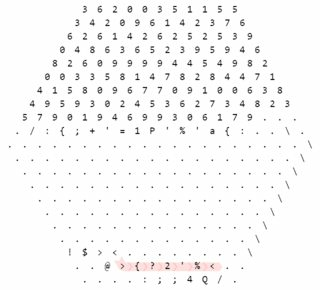204
60
Using your language of choice, golf a quine.
A quine is a non-empty computer program which takes no input and produces a copy of its own source code as its only output.
No cheating -- that means that you can't just read the source file and print it. Also, in many languages, an empty file is also a quine: that isn't considered a legit quine either.
No error quines -- there is already a separate challenge for error quines.
Points for:
- Smallest code (in bytes)
- Most obfuscated/obscure solution
- Using esoteric/obscure languages
- Successfully using languages that are difficult to golf in
The following Stack Snippet can be used to get a quick view of the current score in each language, and thus to know which languages have existing answers and what sort of target you have to beat:
var QUESTION_ID=69;
var OVERRIDE_USER=98;
var ANSWER_FILTER="!t)IWYnsLAZle2tQ3KqrVveCRJfxcRLe";var COMMENT_FILTER="!)Q2B_A2kjfAiU78X(md6BoYk";var answers=[],answers_hash,answer_ids,answer_page=1,more_answers=!0,comment_page;function answersUrl(index){return"https://api.stackexchange.com/2.2/questions/"+QUESTION_ID+"/answers?page="+index+"&pagesize=100&order=desc&sort=creation&site=codegolf&filter="+ANSWER_FILTER}
function commentUrl(index,answers){return"https://api.stackexchange.com/2.2/answers/"+answers.join(';')+"/comments?page="+index+"&pagesize=100&order=desc&sort=creation&site=codegolf&filter="+COMMENT_FILTER}
function getAnswers(){jQuery.ajax({url:answersUrl(answer_page++),method:"get",dataType:"jsonp",crossDomain:!0,success:function(data){answers.push.apply(answers,data.items);answers_hash=[];answer_ids=[];data.items.forEach(function(a){a.comments=[];var id=+a.share_link.match(/\d+/);answer_ids.push(id);answers_hash[id]=a});if(!data.has_more)more_answers=!1;comment_page=1;getComments()}})}
function getComments(){jQuery.ajax({url:commentUrl(comment_page++,answer_ids),method:"get",dataType:"jsonp",crossDomain:!0,success:function(data){data.items.forEach(function(c){if(c.owner.user_id===OVERRIDE_USER)
answers_hash[c.post_id].comments.push(c)});if(data.has_more)getComments();else if(more_answers)getAnswers();else process()}})}
getAnswers();var SCORE_REG=(function(){var headerTag=String.raw `h\d`
var score=String.raw `\-?\d+\.?\d*`
var normalText=String.raw `[^\n<>]*`
var strikethrough=String.raw `<s>${normalText}</s>|<strike>${normalText}</strike>|<del>${normalText}</del>`
var noDigitText=String.raw `[^\n\d<>]*`
var htmlTag=String.raw `<[^\n<>]+>`
return new RegExp(String.raw `<${headerTag}>`+String.raw `\s*([^\n,]*[^\s,]),.*?`+String.raw `(${score})`+String.raw `(?=`+String.raw `${noDigitText}`+String.raw `(?:(?:${strikethrough}|${htmlTag})${noDigitText})*`+String.raw `</${headerTag}>`+String.raw `)`)})();var OVERRIDE_REG=/^Override\s*header:\s*/i;function getAuthorName(a){return a.owner.display_name}
function process(){var valid=[];answers.forEach(function(a){var body=a.body;a.comments.forEach(function(c){if(OVERRIDE_REG.test(c.body))
body='<h1>'+c.body.replace(OVERRIDE_REG,'')+'</h1>'});var match=body.match(SCORE_REG);if(match)
valid.push({user:getAuthorName(a),size:+match[2],language:match[1],link:a.share_link,})});valid.sort(function(a,b){var aB=a.size,bB=b.size;return aB-bB});var languages={};var place=1;var lastSize=null;var lastPlace=1;valid.forEach(function(a){if(a.size!=lastSize)
lastPlace=place;lastSize=a.size;++place;var answer=jQuery("#answer-template").html();answer=answer.replace("{{PLACE}}",lastPlace+".").replace("{{NAME}}",a.user).replace("{{LANGUAGE}}",a.language).replace("{{SIZE}}",a.size).replace("{{LINK}}",a.link);answer=jQuery(answer);jQuery("#answers").append(answer);var lang=a.language;lang=jQuery('<i>'+a.language+'</i>').text().toLowerCase();languages[lang]=languages[lang]||{lang:a.language,user:a.user,size:a.size,link:a.link,uniq:lang}});var langs=[];for(var lang in languages)
if(languages.hasOwnProperty(lang))
langs.push(languages[lang]);langs.sort(function(a,b){if(a.uniq>b.uniq)return 1;if(a.uniq<b.uniq)return-1;return 0});for(var i=0;i<langs.length;++i)
{var language=jQuery("#language-template").html();var lang=langs[i];language=language.replace("{{LANGUAGE}}",lang.lang).replace("{{NAME}}",lang.user).replace("{{SIZE}}",lang.size).replace("{{LINK}}",lang.link);language=jQuery(language);jQuery("#languages").append(language)}}body{text-align:left!important}#answer-list{padding:10px;float:left}#language-list{padding:10px;float:left}table thead{font-weight:700}table td{padding:5px} <script src="https://ajax.googleapis.com/ajax/libs/jquery/2.1.1/jquery.min.js"></script> <link rel="stylesheet" type="text/css" href="https://cdn.sstatic.net/Sites/codegolf/primary.css?v=f52df912b654"> <div id="language-list"> <h2>Winners by Language</h2> <table class="language-list"> <thead> <tr><td>Language</td><td>User</td><td>Score</td></tr></thead> <tbody id="languages"> </tbody> </table> </div><div id="answer-list"> <h2>Leaderboard</h2> <table class="answer-list"> <thead> <tr><td></td><td>Author</td><td>Language</td><td>Size</td></tr></thead> <tbody id="answers"> </tbody> </table> </div><table style="display: none"> <tbody id="answer-template"> <tr><td>{{PLACE}}</td><td>{{NAME}}</td><td>{{LANGUAGE}}</td><td><a href="{{LINK}}">{{SIZE}}</a></td></tr></tbody> </table> <table style="display: none"> <tbody id="language-template"> <tr><td>{{LANGUAGE}}</td><td>{{NAME}}</td><td><a href="{{LINK}}">{{SIZE}}</a></td></tr></tbody> </table> 






4Do you not mean, "Golf you a quine for greater good!"? – Mateen Ulhaq – 2011-05-03T02:49:07.960
51@muntoo it's a play on "Learn you a Haskell for Great Good". – Rafe Kettler – 2011-05-03T02:52:14.103